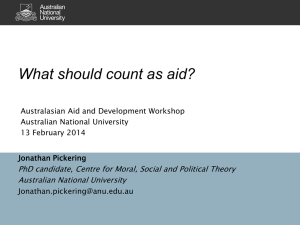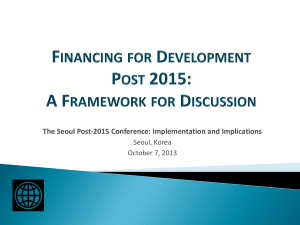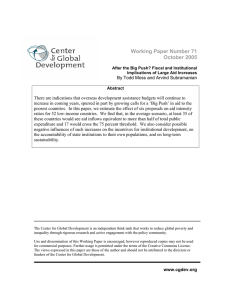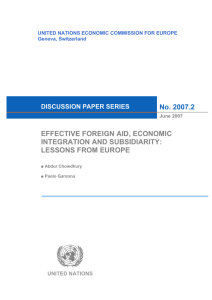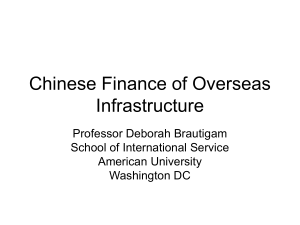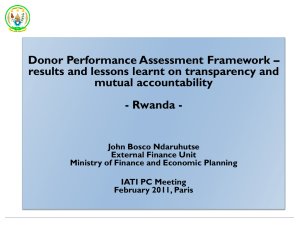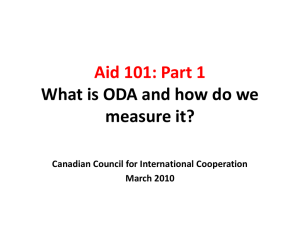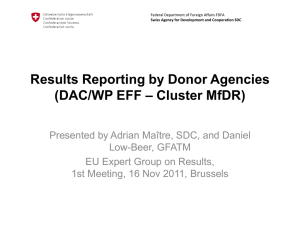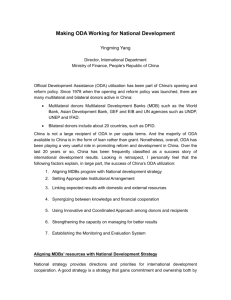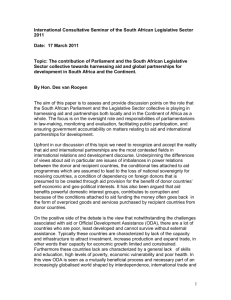Development Assistance - ECON 3510 – African Economic
advertisement
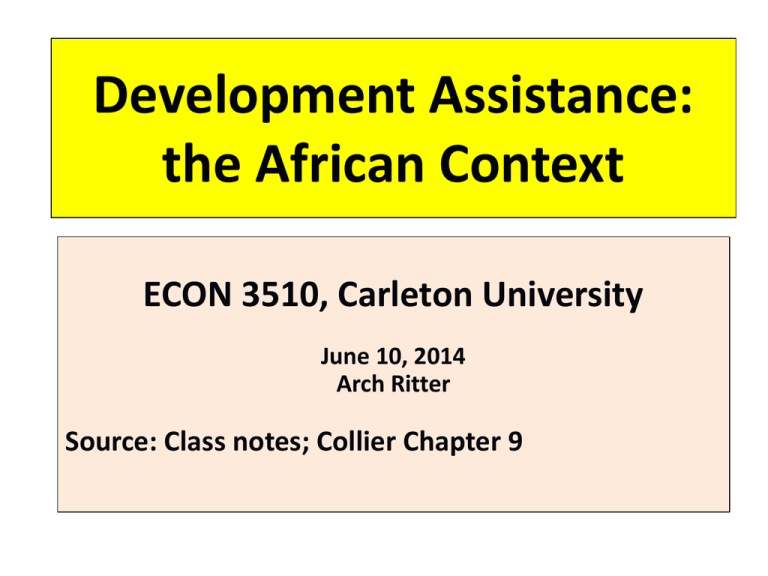
Development Assistance: the African Context ECON 3510, Carleton University June 10, 2014 Arch Ritter Source: Class notes; Collier Chapter 9 Agenda 1. Definition: What is "Aid“ 2. Historical Evolution 3. Donor Motives for Providing "ODA" 4. Ethical Justification 5. What Can "Aid" Accomplish? The Positives 6. Possible Negative Impacts 7. Magnitudes, and Patterns 8. Development Assistance to Africa 9. Problems of Aid Quality 10. How Can Development Assistance Be Improved? 1. Definitions: “ What is Aid and ‘ODA’ ” • “Development Assistance” or “Aid” would include a) Multilateral or Governmental (i.e. “ODA”), b) NGO, and Private Grants plus c) the grant component of Highly Concessional Loans • “Official Development Assistance”: Net disbursements of loans (on concessional terms) or grants by governmental agencies for development purposes All Aimed at Transferring Resources – In Currency or In Kind; All “ Pro-Developmental” or Emergency Relief, not “Welfare” Oriented • Non-Commercial from Donor Perspective Where do the following fit in? • Donations to and through NGOs or Foundations (e.g. Gates Foundation, Oxfam, CARE, Red Cross) • “Faith-based” organizations (Caritas, Mennonites, Vision, Aga Khan Foundation) • “Private assistance” provided unofficially and usually without much publicity and perhaps without official awareness by individuals or groups. 2. Historical Evolution Marshall Plan Cold War impetus Gradual expansion to 1990s, decline then renewal Citizen, “Faith-based” and NGO Initiatives Millennium Development Goals Current questioning of aid effectiveness: Bill Easterly Dambisa Moyo of Zambia 3. Donor Motives for Providing ODA Political and Historic –e.g. Commonwealth & Francophone connections –Win friends & influence people Strategic/military –note the impact of the Cold War Commercial Humanitarian Ethical 4. Ethical Justification: Should High Income Countries Provide Aid to Low-Income Countries? “First step towards world fiscal federalism” 5. What can Aid Accomplish? Aims at “Development” not Welfare The potential positives of aid 1. “ Gap-Filling Role”: foreign exchange, tax revenues, technological, managerial entrepreneurial gaps 2. A “Catalytic Role”? 3. Capacity-Building Role 4. Direct Basic Human Needs or MDG Filling Role 5. Emergency Relief & Reconstruction Role – Promote Re-Construction of War-torn Lands – Regional flood, famine, military, and political crisis relief 6. An Investment in Internationally Shared Security as well as Shared Prosperity? The Range of Types of Assistance Organization Multilateral: World Bank National CIDA (Africa Program) Major Foundations: Bill and Melinda Gates Foundation NGOs: “CanAssist”; “Academics Without Borders Canada” Faith-Based Programs: Mennonite Central Committee Aga Khan Foundation Note: the above labels are hyper-linked to the organizations’ web sites 6. Possible Negative Impacts of ODA 1. May permit recipients to pursue counterproductive or foolish policies • May support an ineffective, counterdevelopmental and corrupt government 2. May Promote a “Dependency Welfare Syndrome”? • Leadership & responsibility may be abdicated by national governments and/or taken by foreign aid agencies, NGOs ….. 3. May deform domestic policies to accommodate priorities of donors Possible Negative Impacts of ODA, cont’d 4. May permit donor to exercise inappropriate influence on recipient 5. May permit recipient country to shift resources to other undesirable areas 6. Volatility of aid flows may be hurtful to recipient Possible Negative Impacts of ODA, continued 7. May lead to appreciation of exchange rate with damage to export activities (See Chart) 8. May provide discretionary funds for governments where officials are involved in corruption 9. May support dictatorial regimes that violate human rights in major ways Development Assistance to Selected Countries of Africa Net Aid from All Donors as % of GDP, 2003 Net Aid per Capita, from All Donors 2003 Net Aid as % of Gross Domestic Investment, 2003 Burundi Cabo Verde Eritrea Ghana Guinea-Bissau Malawi Sao Tome South Africa Tanzania 37.6 18.0 40.9 12.1 60.8 29.3 63.2 0.4 16.2 31 306 70 44 98 45 239 14 47 246.1 89.2 182.5 52.4 490.7 260.6 210.0 2.2 87.9 Sub-Saharan Africa Excluding South Africa Excl. S. Africa & Nigeria 5.6 34 29.9 8.2 33 41.9 11.2 44 60.4 Selected Countries Aid is not always given to the poorest countries 7. Magnitudes and Patterns Donor Efforts Magnitudes and Patterns: Donor’s Efforts But note: Previous “ODA” numbers do not include • Donations to and through NGOs or Foundations (e.g. Gates Foundation, Oxfam, CARE, Red Cross) • Nor “faith-based” organizations (Caritas, Mennonites, Vision, Aga Khan Foundation) • Nor “private assistance” provided unofficially and usually anonymously by individuals. 8. Development Assistance to Africa Africa receives about 50 per cent of total aid 0.40 0.36 140 0.35 120 0.30 0.30 % of GNI 0.26 0.25 0.20 ODA as a % of GNI (left scale) 100 80 0.22 Total ODA (right scale) 0.15 60 40 0.10 20 2010 0 2009 2008 2007 2006 2004 2003 2002 2001 2000 1999 1998 1997 1996 1995 1994 1993 1992 1991 1990 0.00 2005 Total ODA to Africa (right scale) 0.05 ODA (2004 $ billion) 0.33 Source: OECD/DAC Statistics (2006). DAC Members’ ODA: 1990-2004 and simulations to 2006 and 2010, based on Monterrey and subsequent commitments ODA increases have been driven by debt relief and emergency assistance 2003 US$ billion 28 26 24 22 20 18 16 14 12 10 1993 1994 1995 1996 1997 1998 1999 2000 2001 2002 2003 2004 other ODA Bilateral debt forgiveness Emergency aid Total net official development assistance (ODA), non-aid official flows and private flows in Africa, 1993-2004. (Source: OECD/DAC) Development Assistance to Selected African Countries Selected Countries Net Aid from All Donors as % of GDP, 2003 Net Aid per Capita, from All Donors 2003 Net Aid as % of Gross Domestic Investment, 2003 Burundi Cabo Verde Eritrea Ghana Guinea-Bissau Kenya Malawi Nigeria Sao Tome South Africa Tanzania 37.6 18.0 40.9 12.1 60.8 3.4 29.3 0.6 63.2 0.4 16.2 31 306 70 44 98 15 45 2 239 14 47 246.1 89.2 182.5 52.4 490.7 26.0 260.6 2.4 210.0 2.2 87.9 Sub-Saharan Africa 5.6 34 29.9 Macroeconomic Indicators, Some African Countries Liberia Gross Investment Kenya Ethiopia Tanzania Sierra Leone 16.4% 19.4% 10,2% 16.4% 14.7% 17.1% 0.3% 0.4% 3.6% -o.2% Development Assistance Per capita $329 $35 $41 $54 $66 Remittances % of GDP Per capita, $ 6.9% $15 5.1% $44 1.5% $5. 0.1% $0.0 7.7% $27 Tax Revenues, n.a. 18.9 10.2% n.a. 10.8% % of GDP Foreign Direct Invest ‘t % of GDP % of GDP UNDP. HDR, 2010 DFAIT-Development (formerly CIDA) Countries of Focus in SubSaharan Africa 2007-2008 DFAIT-Development (ex-CIDA)’s Mission and Mandate Mission: Lead Canada's international effort to help people living in poverty. Mandate: Manage Canada's support and resources effectively and accountably to achieve meaningful, sustainable results and engage in policy development in Canada and internationally, enabling Canada's effort to realize its development objectives. Comment re accountability and effectiveness Example of Canadian Assistance: Ethiopia Achievements 2011-2012 Children and youth Contributed to 7.1 million children receiving essential vitamins and minerals. Increased, by 55 percent, the detection of tuberculosis and successfully treated 85 percent of all cases reported in 314 remote villages. Trained more than 20,000 health workers to treat childhood diseases from 2007 to 2012. Contributed to an increase in the proportion of children vaccinated against diphtheria, whooping cough and tetanus to 88 percent and against measles to 86 percent. Helped increase the proportion of births attended by health workers by 5 percent (to 34 percent). Distributed anti-malarial bed nets to households in malaria-prone areas, maintaining a rate of 100 percent coverage. Food security Supported the Productive Safety Net Program, a cash-for-work program that helped feed 7.6 million people while at the same time addressing underlying causes of food insecurity with construction of soil conservation structures and tree planting. Trained 3,274 health workers who contributed to improving the health and nutritional status of pregnant and breastfeeding women and of 1.5 million under-five children. CIDA-Funded Projects in Sub-Saharan Africa – by Country and in Aggregate: See “ Project Browser” CIDA Projects in Africa Recent shift by Canada away from Africa in Aid Allocation and towards Latin America? - With lots of rhetoric but not much action; Rationale? Unclear 9. Problems of Aid “Quality” • Predictability and volatility – During 2001-03 the gap between commitments and disbursements exceeded 2% of GNI for 35 countries • Conditionality • Coordination: a problem – On average, a country in SSA dealt with more than 30 donors in 2002 – In 2002 Senegal hosted over 50 World Bank missions – In 2003 Zambia hosted 120 donor missions 7. Some Specific Issues: • Allocation of Burden among Donors • Allocation of Aid among Recipients • Executing Agencies: IFIs, Bilateral, Civil Society Organizations? • Food Aid: Impact on Domestic Agriculture • Co-ordination of Aid Programs • Aid, Human Rights and "Bad" Political Regimes • The tying of aid: – Why “Tie” Aid? – Effects of “Tying” – Positive Effects of “Tying” ? – Solutions? What can we realistically expect development assistance to accomplish? Recall what can go wrong: 1. Aid may “ratify” counter-productive policies 2. “Dependency Welfare Syndrome”: Recipient country effort may be reduced 3. Donors priorities may dominate 4. Inappropriate donor influence 5. May permit recipient country to shift resources to other undesirable areas 6. Aid volatility may damage recipient 7. Appreciation of exchange rate may block exports, increase imports, & economic diversification 8. Discretionary & unearned funds for government may encourage & facilitate corrupt practices 9. May support dictatorships and human rights violations Conclude: • Aid alone can not achieve sustainable development • A useful support for domestic or national efforts. • Responsibility rests with developing countries themselves, not aid donors • Perhaps neither “sufficient” nor “necessary” but useful. Other factors are vital: • Governmental commitment to development • • • • objectives; Reasonably incorrupt government Equity orientation of public policy Sound economic policies to strengthen and sustain an indigenous economic foundation An “enabling environment” so that people can improve their own situations for themselves (e.g. re the informal sector, micro-credit ….” Question: Is representative democracy a necessary precondition or element? 10. How Can Development Assistance Be Improved? 1. Increase the Quantity of Development Assistance? 2. More grants & fewer loans 3. Link Aid More Directly to Need? 4. Further Debt Service Reductions? 5. Donor co-ordination via “consortium technique But recall that aid is no panacea and also creates additional problems and stresses Can More Aid be “Absorbed” or Used Effectively? Would it lead to a collapse of domestic effort (e.g. taxation; F. Xch. earnings etc.)? Would it promote “Dutch Disease” Would it sap indigenous efforts and initiatives Could it be used effectively? Would it permit increased corruption? Would donor priorities take over? Would high levels of aid institutionalize dependence? 10. How Can Development Assistance Be Improved? Continued: For the Donors: Improve the “Quality” of Aid 1. A “Partnership” philosophy and approach 2. Orchestrate programs to avoid chaos, Use a “consortium” approach 3. Reduce administrative burdens placed on recipient governments 4. Minimize aid volatility & unpredictability 5. Reduce the tying of aid to donor suppliers 6. Increase untied budget support? Increased “Program Aid not Project Aid” 7. Emphasize capacity building How Can Development Assistance Be Improved? Continued: (b) for the Recipients: – Pursue wise, equitable and effective development strategies – Make a major domestic effort – “Take Charge” & “Own” the Program – Improve budget management and accountability; combat corruption; – Ensure effective management; – Avoid currency appreciation due to aid inflows (“Dutch Disease”)

